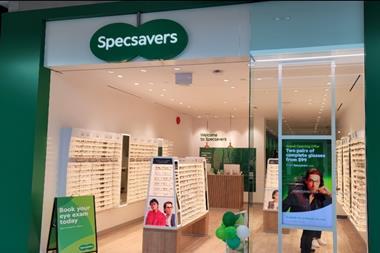Alight from the train at Aylesbury and you have reached the end of a line that begins at London’s Marylebone station less than an hour away. Yet you have left the urban sprawl, traversed the Chilterns and arrived at the beginning of Middle England.
First impressions are that this is not the most affluent place you are ever likely to visit. But the substantial number of retail parks and sheds that lie just beyond the station indicate a population that likes to shop and one that is determinedly mid-market. From most perspectives, this is an archetypal small town, where levels of unemployment will be about average, as will the ethnic mix and the number of Ford Mondeos that you are likely to encounter as you try to cross any of the big roads that encircle the centre.
Directly off one of these lies The Junction Retail Park, the setting for a UK retail first. The Junction is the fortunate recipient of a new retail fascia, one that has been brought to the town by Home Retail Group, the parent company of Argos and Homebase that was created when GUS demerged in October last year.
The store in question is Home Store & More and for those who have visited the Airside Retail Park in Swords, a stone’s throw from Dublin Airport, it will not be entirely unfamiliar. The Aylesbury store is a UK take on a format that was created by an Irish entrepreneur. The right to use both name and retail concept in this country was bought by Home Retail earlier this year and The Junction Retail Park store is the first indication of what the catalogue and DIY retailer intends to do with its new brand.
The first point to make is that Home Retail regards what is on view at Aylesbury as a work in progress and therefore refuses to comment on what has been done. There are, however, a few salient facts that are in the public domain. The store is about 20,000 sq ft (1,860 sq m), is a basic shed and sells everything from wicker linen baskets to Jamie Oliver-branded cookware.
From the outside, it is only marginally different from its Irish precursor. The logo has been altered and, in place of the cross representing “and”, there is now an ampersand and all of the words have been run together to create a single entity.
Other than these details, this is standard shed territory and the message from the posters on either side of the entrance is that this is a shop with a strong focus on price. Carrying this set of expectations into the shop, it is perhaps no surprise that one of the first things that catches the eye is a pallet-style display piled high with boxes containing knives and knife blocks. Surmounting all of this is a large, red box bearing the legend “Star buy” and, reinforcing the message, “Don’t miss it!” This is low-price-cum-bargain land, or at least that’s what the point of sale seems to indicate.
And, as befits this kind of offer, the layout is very simple and easy to understand. In essence, the store is a large square with a square mat in its middle and a walkway running around it. The benefits of this format are that shoppers tend to follow the walkway and it makes creating departments straightforward.
Perhaps because this is a shopping journey where you are likely to end up where you started, the cash-taking area is just inside the entrance. Most shoppers seem to follow the store’s racetrack in an anticlockwise direction. If this is the chosen modus operandi for a tour of the shop, the first area that will be encountered is a wall of products under the banner “Kitchen basics” and a vast array of kitchen electrical devices, situated across the walkway in the central shop area.
Every possible part of the store has been merchandised, with a resulting stock density that is significantly above average. In the kitchen area, for instance, there is a wall of cutting tools extending up about 13ft (4m) from floor level, meaning that some of the items on display are hung 10-high on a slat-wall. This is power merchandising of a sort and means that the store’s walls act as a forward reserve, cutting back on the need for staff to spend time replenishing stock.
It also means that no quarter is given for graphics or any of the visual merchandising tricks of the trade that you might normally expect in a store of this nature. In front of the perimeter wall are low units with very basic messaging of a predictable nature – “Low prices, every day”, being typical of what’s on view.
Sensory overload
The inference from the way in which the stock is crammed onto shelves, walls and mid-shop unitry is that shoppers will browse. If they don’t, even allowing for the commendably simple overhead navigational signage, much will be missed.
Moving on from kitchenware towards the back of the shop, you pass cookware, tableware and glassware. The cookware department differentiates itself with a Jamie Oliver offer that features point-of-sale material and boasts two small flatscreen TVs showing the man in action.
If it weren’t for this, it would be almost possible to walk around this part of the shop without stopping. Such is the profusion of stock that it can act as the visual equivalent of white noise; in short, there is so much of everything that you don’t notice any of it.
The back of the shop marks a shift from eating and drinking to sleeping and ablutions. Rugs, duvets and bed linens take shoppers into the final stretch, where they will pass towels and bathroom products and end up in the bins and containers department. Even the walkway is put to work, with price-promoted pallets and tumble bins of stock featuring almost throughout. The impression is utilitarian.
And so to the tills. The design of these is as functional as the rest of the shop and there is no room for frippery of any kind.
Shoppers will probably leave the store with their purchases without forming any opinion one way or the other about the way the store looks. But this is rather the point. The UK’s first Home Store & More is the ultimate non-experience, one where everything has been rammed in, in a way that lends it something of the appearance of an old-fashioned hardware shop or an early Matalan format. If it proves popular, it will certainly be in spite of, rather than because of, its looks.
This may be a work in progress, as Home Retail claims, but judged against the Dublin store on which it is modelled, there has been relatively little forward movement. And it is hard to see where it might go next.


























No comments yet